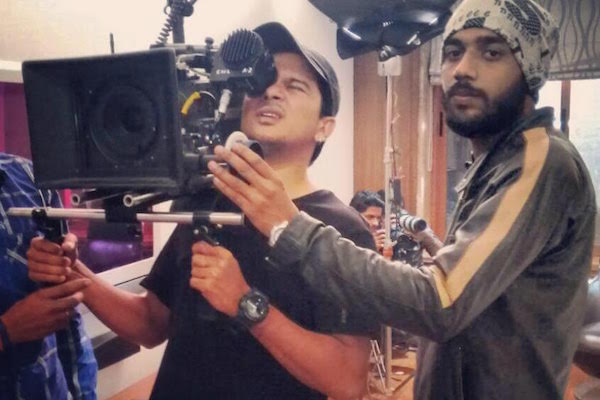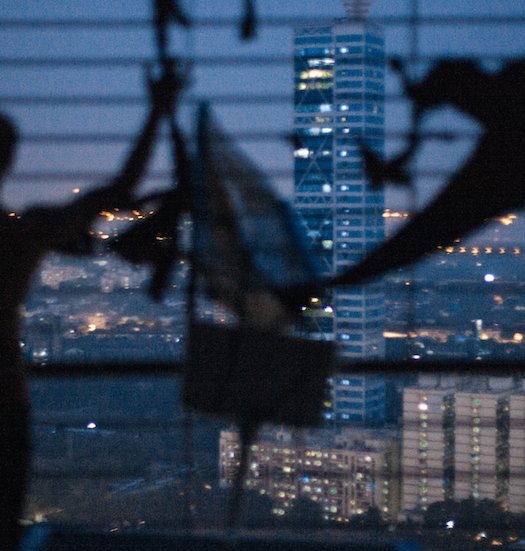People will see an amazing side of India in SMTT – Arshad Khan
Shailendra Singh’s debut film Sunshine Music Tours and Travels has generated interest on many accounts – from the unique concept of the film to the huge pool of talent (The film has 170 people making their debut) that it is introducing to the industry. One such debut is that of Cinematographer Arshad Khan. Khan has vastly been associated with travel shows and documentaries, making him a perfect fit for this travel and music film. His work in the documentary, ‘A Tale of Two Veils’, was one of the semifinalists film for the Student Academy Awards (Student Oscar) and was highly appreciated across the board.
In a chat with Pandolin, Khan gives a peek into the cinematography Sunshine Music Tours and Travels. From shooting at the Sunburn festival, to the overall look and feel of the film, Khan has a lot to share.

Arshad Khan (Left)
How did you get associated with Sunshine Music Tours & Travels? What were the factors that encouraged you to become part of the movie?
I started as an assistant to Dhimant Vyas majorly on ad films and did that for almost two and half years. I then did independent projects which mostly consisted of travel shows and documentaries, both of which helped me in this film because it had a similar vibe; we had to work fast, there was a lot spontaneity and we had to travel a lot.
I’ve previously worked with Shailendra Singh for his web series and short films, both of which were very well received. He always had this dream of making this movie called Sunshine Music Tours & Travels. So one day, Shailendra sir called me up and told me about this movie that he was planning to make and asked me if I would work with him, in fact, he asked me if I would be able to do it (laughs). And, I told him, “Why not!, there is a first time for everything.”
If people don’t get an opportunity to showcase their talent, how will they go ahead in life? A great thing that Shailendra sir is doing is that he is giving young talent a platform to perform. He has known me for a few years now and respects my work, so the bonding was present.
READ: SHAILENDRA SINGH LAUNCH SUNNY KAUSHAL IN HIS DIRECTORIAL DEBUT
The movie was actually shot during the Sunburn festival, were there any challenges that you faced during the shoot?
I had an experience of shooting at Sunburn as I’ve worked on the after-movies of the festival in the past. I’ve been the lead DOP there, therefore, I knew how things worked and more importantly, I knew what needed to be covered. Fortunately, my past experience helped me a lot during the film and I was lucky that for my first movie I ended up at Sunburn.
What was the kind of camera setup that you adopted while shooting Sunburn?
During the festival there were already eight to ten broadcast cameras that were rolling live. So we used that footage. Besides that we used the footage of the making of Sunburn as there is a team of eight to ten professionals who work on it. Our main camera crew comprised two people and a Red Epic camera and that is how we shot the sequence at the Sunburn festival.
We had planned that once the main event starts we had to be alert and had to cover it properly. But on the other hand, we had to be spontaneous as well because there were almost two lakh people, so no matter how much you plan, you have to be prepared for anything. When we went there with the actors, we had to capture their energy and emotions. Therefore, we tried to keep it as real as possible.
And what about the camera setup during the journey? What was the process of shooting the travel sequences like?
We had so much fun while traveling and shooting this movie that the entire crew became like a family. Shailendra sir has his own unique way of working. While traveling we would shoot some dialogues inside the bus, then if we saw any good locations we would stop there. If I would see a beautiful farm, we would shoot something there or if there was a beautiful sunset, we would shoot a light moment around it. Though we did plan, the film was very spontaneous and we often ended up doing things that weren’t even there in the script. It would depend on the energy of the place and the space.
READ: WHAT I AM DOING NOW IS MORE OUT OF PASSION THAN BUSINESS- SHAILENDRA

With Shailendra Singh (Extreme Left)
As the movie is about a road trip, how did you deal with the lighting design, were there any major issues that you had to tackle?
It was not all difficult. In fact, cinematography is very simple, people make it complicated. It has nothing to do with the camera or lens; cinematography is about storytelling. Coming to the lighting, we had minimalistic light and here my documentary and travel show experience came handy. We had basic LED lights and we used a very naturalistic and realistic approach. Since it was outdoors, we did not have to bring additional lights to play with. Besides a few LEDs, nothing much was required.
Could you throw some light on the color palette adopted? Sid it vary according to the location or was a constant palette followed?
The one thing that we lack in Indian cinema is in the color grading and DI (Digital Intermediate). The reason that most of our films look the same and that Hollywood films look different is because they give more time for the DI. Therefore, while working on the movie I had certain things in mind as every color speaks or represents emotions as well as a phase in the story.
For Kashmir, I chose blue to represent a cooler palette as it’s more soothing and reflects a simple lifestyle that the two characters were living, in the Himalayas. It gave a slightly less saturated feel and defined their feeling towards the journey that they were about to pursue. Then as they reach Delhi, I gave it a warmer tone as they have started the journey and this is the time when people start to board the bus. It continues to have a warmer tone and in Rajasthan the film gets exuberant and progressive as the journey goes on. The third part, which is in Goa, was kept vibrant and colorfully saturated as the character felt that they are about to reach their dream destination. Keeping it colorful gave it a sense of celebration; here they were celebrating life and music, which Sunburn is all about. It also represented the achievement of one’s dreams.
How would describe the overall look of the film?
It is a very feel-good vibrant film; full of colors, life and emotions. Most importantly, it has music and I think that music is the godfather of every art form. People will see something different in this movie; they will see an amazing side of India. You will get to see everything from snow to the desert to blue waters and white sand.
READ: MEET THE ENSEMBLE OF SUNSHINE MUSIC TOURS AND TRAVELS
Your documentary ‘Tales of Two Veils’ was recently chosen as a semifinalist for the Student Academy Awards, which is a first for India. Tell us about it.
We shoot that movie last year in Rajasthan and it was a self-funded project, we had a very small budget to support us. It is women-centric film and tells a story about two women and their journey to empowerment. The movie narrates how even with the odds against them, they give courage and hope to their families. There are basically two stories, one tells the story about a woman taking care of a paralyzed husband and her family, while the other is about a woman working in an NGO and supporting women who need help. It deals with women surviving in a patriarchal society along with other issues that most people might not be aware about.



